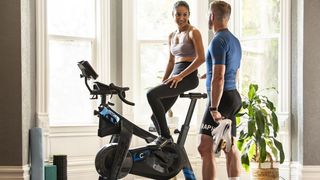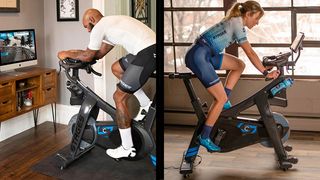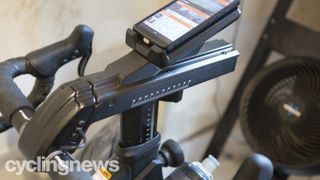Seven reasons to upgrade from a smart trainer to a smart bike
Why you should consider stepping up from indoor trainer to a dedicated smart bike

There are countless benefits to riding indoors instead of out, and it doesn't matter whether you've not ridden a bike in 30 years, are a seasoned veteran training for your next century, or an aspiring pro looking to win races on Zwift, cycling indoors in today's age has something for everyone.
In years gone by, indoor cycling meant bolting your bike to a basic turbo trainer, riding a training session via memory and a stopwatch - perhaps a Garmin computer for reminders if you were lucky - while listening to music to take your mind off the boredom. Nowadays, thanks to the advent of smart turbo trainers and apps such as Zwift and RGT, indoor cycling is interactive and immersive. Your real-world power output controls your on-screen avatar and via the internet you can ride with (or race against) people from around the world. The app can send signals back to your trainer to adjust resistance levels automatically, adding realism for ascending and descending, or simply helping you to maintain your power targets if intervals are your thing.
Indoor cycling transformed. Nowadays, it's not reserved for the hardened athletes who want to chase performance, it's for everyone. It can be social, competitive, motivating and fun.
However, in the past few years, a better way to train indoors has emerged: the smart bike.
Smart bikes such as the Stages SB20 take everything that's good about a smart turbo trainer and build it into a standalone bike to offer a multitude of additional benefits. In this article, we're going to explore those benefits in a bid to help you understand why the smart bike is the right choice for your home's indoor cycling needs.

1. Share and share alike
If you live in a multi-cyclist household, you may be aware of the frustration of coming home from work to find that your partner / friend / sibling has removed your bike from the turbo trainer, fitted theirs, completed their workout and left their bike in place. Having to remove their bike (which is never as clean as yours), and fit yours before you can ride is a time-consuming process that only eats into your ride time. Especially if that swap also requires a freehub change from SRAM to Shimano.
With a smart bike, all that's needed is a quick change of the saddle height and handlebar position and you're ready to go. The hardest thing you might need to do is swap the pedals, which is a quick job that, on the Stages SB20 at least, allows you to change the crank length too - helping you dial in your fit even more.
2. A smart bike is quieter
With smart bikes, there's typically no chain or derailleur like you have on a normal bike. Instead, they usually use a belt drive system. For example, the Stages SB20 uses a fully-silent Gates carbon belt drive, which is completely enclosed within the bike's framework, paired with an electronic gear system that is just as silent. That means there's no constant noise of your drivetrain while you're riding and no clunk of gears when you drop the hammer in a race.
As a result, none of your family members, neighbours, or even the pet dog will need to be disturbed by your early-morning races. That is until you forget it's 6 AM and you celebrate too loudly when you win! (don't worry, we all get caught up in the moment sometimes)
3. Smart bikes are also clean bikes
Continuing on from the reasons why a smart bike is quieter, fully enclosing the drivetrain means there's no greasy components exposed to the world, unlike the one on your road bike. Therefore, there's no oil-covered chain to stain your hands, the sofa, the kids, the dog, or anything else that happens to come within two metres of it.
4. No more maintenance
While a chain-driven system needs you to ensure the chain is properly lubricated, and then cleaned after you've sweated all over it or it has attracted dust, another benefit of the enclosed belt-driven drivetrain is that it requires absolutely no day-to-day maintenance. This lack of maintenance means the only thing you need to worry about is keeping the the bike itself clean - something you'd also have to do with a normal bike - which in turn means more time available to ride! And isn't that why we're here after all?

5. Better performing
Let's cut to the chase: we'd all love to own the best, lightest, fastest, most aero bikes when it comes to riding on the road, so why should we settle for second-best when it comes to riding indoors? Not only are smart bikes quieter, cleaner and easier to maintain, but they are also simply better.
Firstly, the electric gears mean instant shifting no matter how much torque you're putting through the pedals. There's no need to hold back on your power output to get a smooth shift, it's just immediate every time.
Secondly, because it's a standalone bike, it's not built with an eye on the UCI's 6.8kg weight limit and as a result, smart bikes can be stiffer, more durable, and they can be a huge amount more stable.
They can also be designed with inbuilt concessions to the needs of an indoor cyclist. For example, the SB20 comes with a tablet and mobile phone holder, putting them both in your eye line so you can keep an eye on your workout without needing an expensive 'turbo trainer desk' or an unstable ironing board propped up next to you. What's more, it comes with a best-in-class 50lb flywheel for an unrivalled road feel, and truly independent left-right power measurement thanks to Stages' reputable power meters.
6. A smart bike is always ready to go
If you have a dedicated space for your indoor cycling sessions, then you can leave your smart bike in situ, and it'll be there, ready and waiting for you whenever you need it. A true plug-and-play solution to your Zwifting needs.
Sure, it's possible to leave your bike attached to a turbo trainer, but if you then choose to ride that bike outside, you'll have to re-fit it to your trainer once you get home. If your training space is in your home, rather than a garage or a shed, then it may mean you need to clean and dry the bike before you bring it indoors, and even if not, that's valuable time that could be better spent helping you reach your goals.
7. Save your best bike for the best days
Many of us are only fortunate enough to own one bike, and the last thing you want for your pride and joy is to banish it to the 'pain cave' to be sweated on all winter. Not only can that sweat result in corroded components, but the simple extra mileage that will go through your drivetrain will wear out components at a faster rate.
This can ultimately mean that when you come to take the bike outside again in spring, it's in need of a serious service that will cost money you could have otherwise spent on the smart bike in the first place. What's more, given the current parts shortage, it could mean an extended period off the bike while you wait for it to be fixed. Don't take that risk. With smart bikes like the SB20, you can immediately replicate your on-road position thanks to the easily adjustable saddle, bars and cranks, and train just like you were riding your normal bike, but without the added wear and tear that comes with it.

Bonus. Trial and error
Given the easily adjustable nature of a smart bike, it's the perfect companion for a bit of trial and error. Ever wondered if you'd be more comfortable with a longer stem or shorter cranks? Don't worry about spending on new components for your road bike just to see how it goes, simply adjust the handlebar reach on your smart bike, swap your pedals to the different hole and try before you buy. Spend a few hours of ride time in your new position, check whether it causes any unexpected niggles and get a feel for how it affects your performance before you spend the big bucks.
Get The Leadout Newsletter
The latest race content, interviews, features, reviews and expert buying guides, direct to your inbox!
Cyclingnews is the world's leader in English-language coverage of professional cycling. Started in 1995 by University of Newcastle professor Bill Mitchell, the site was one of the first to provide breaking news and results over the internet in English. The site was purchased by Knapp Communications in 1999, and owner Gerard Knapp built it into the definitive voice of pro cycling. Since then, major publishing house Future PLC has owned the site and expanded it to include top features, news, results, photos and tech reporting. The site continues to be the most comprehensive and authoritative English voice in professional cycling.
